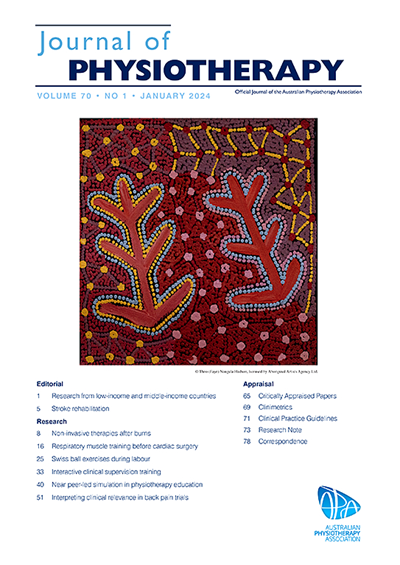Exercise adherence is associated with improvements in pain intensity and functional limitations in adults with chronic non-specific low back pain: a secondary analysis of a Cochrane review
IF 9.7
1区 医学
Q1 ORTHOPEDICS
引用次数: 0
Abstract
Question
What is the association between exercise adherence and the effects of exercise on pain intensity and functional limitations in adults with chronic non-specific low back pain (CNSLBP)?
Design
Systematic review with meta-analysis.
Participants
Adults with CNSLBP.
Intervention
Randomised controlled trials of exercise compared with no exercise (eg, usual care, placebo/sham or another conservative treatment). Adherence to exercise must have been reported.
Outcome measures
Pain intensity and functional limitations.
Results
This study included 46 trials with 56 exercise groups. High exercise adherence (80 to 100%) was associated with reduced pain intensity (0 to 100 scale) (MD –14.32, 95% CI –18.61 to –10.03, low certainty) and functional limitations (0 to 100 scale) (MD –8.08, 95% CI –10.68 to –5.49, low certainty). Moderate exercise adherence (60 to 79%) was not associated with reduced pain intensity (MD –4.53, 95% CI –9.39 to 0.34, very low certainty) or functional limitations (MD –2.75, 95% CI –6.00 to 0.51, very low certainty). Low exercise adherence (< 59%) was associated with reduced pain intensity (MD –5.33, 95% CI –10.00 to –0.66, low certainty) and functional limitations (MD –4.43, 95% CI –7.14 to –1.72, moderate certainty). Compared with low adherence, additional differences in outcomes for moderate and high adherence were mostly negligible.
Conclusion
Higher exercise adherence is associated with larger improvements in clinical outcomes in adults with CNSLBP, although overall differences are small compared with lower adherence. Other factors besides adherence between the trials and exercise programs could explain these results. Further research is needed to determine the causal effect of exercise adherence on outcomes in adults with CNSLBP.
Registration
PROSPERO CRD42023447355 and Open Science Framework https://osf.io/7p6dw/.
坚持运动与慢性非特异性腰痛成人患者疼痛强度和功能限制的改善相关:Cochrane综述的一项二次分析。
问题在患有慢性非特异性腰背痛(CNSLBP)的成年人中,坚持锻炼与锻炼对疼痛强度和功能限制的影响之间有何关联?参与者:患有慢性非特异性腰背痛的成年人:干预:干预措施:运动与不运动(如常规护理、安慰剂/沙姆或其他保守疗法)相比的随机对照试验。结果测量:疼痛强度和功能限制:结果:疼痛强度和功能限制:该研究包括 46 项试验,56 个运动组。运动依从性高(80% 至 100%)与疼痛强度(0 至 100 分)降低(MD -14.32,95% CI -18.61 至 -10.03,低确定性)和功能限制(0 至 100 分)降低(MD -8.08,95% CI -10.68 至 -5.49,低确定性)相关。中度锻炼依从性(60% 至 79%)与疼痛强度降低(MD -4.53,95% CI -9.39至0.34,确定性极低)或功能限制(MD -2.75,95% CI -6.00至0.51,确定性极低)无关。运动依从性低(< 59%)与疼痛强度降低(MD -5.33,95% CI -10.00至-0.66,低度确定性)和功能限制(MD -4.43,95% CI -7.14至-1.72,中度确定性)有关。与低依从性相比,中度和高度依从性在结果上的额外差异大多可以忽略不计:结论:较高的运动依从性与CNSLBP成人患者临床结果的较大改善相关,尽管与较低的依从性相比,总体差异较小。除了试验和运动项目之间的依从性外,其他因素也可能解释这些结果。要确定坚持锻炼对中枢神经系统脑病(CNSLBP)成人患者预后的因果效应,还需要进一步的研究:PROSPERO CRD42023447355 和开放科学框架 https://osf.io/7p6dw/。
本文章由计算机程序翻译,如有差异,请以英文原文为准。
求助全文
约1分钟内获得全文
求助全文
来源期刊

Journal of Physiotherapy
ORTHOPEDICS-REHABILITATION
CiteScore
11.40
自引率
7.40%
发文量
69
审稿时长
72 days
期刊介绍:
The Journal of Physiotherapy is the official journal of the Australian Physiotherapy Association. It aims to publish high-quality research with a significant impact on global physiotherapy practice. The journal's vision is to lead the field in supporting clinicians to access, understand, and implement research evidence that will enhance person-centred care. In January 2008, the Journal of Physiotherapy became the first physiotherapy journal to adhere to the ICMJE requirement of registering randomized trials with a recognized Trial Registry. The journal prioritizes systematic reviews, clinical trials, economic analyses, experimental studies, qualitative studies, epidemiological studies, and observational studies. In January 2014, it also became the first core physiotherapy/physical therapy journal to provide free access to editorials and peer-reviewed original research. The Australian Physiotherapy Association extended their support for excellence in physiotherapy practice by sponsoring open access publication of all Journal of Physiotherapy content in 2016. As a result, all past, present, and future journal articles are freely accessible, and there are no author fees for publication.
 求助内容:
求助内容: 应助结果提醒方式:
应助结果提醒方式:


